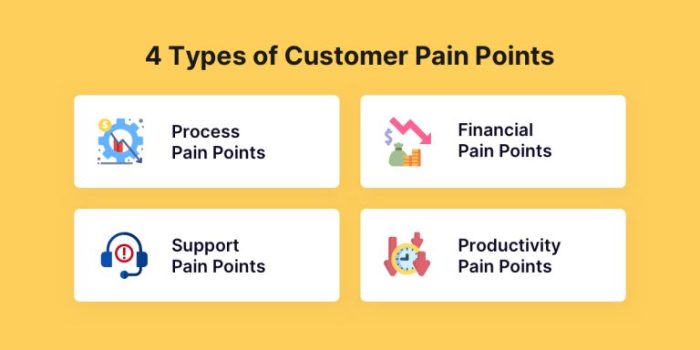Understanding Customer Pain Points sets the stage for businesses to thrive by delving into the core issues that impact customer satisfaction and loyalty. Dive into this crucial aspect of business strategy to unlock the secrets of success.
Exploring various methods and tools to identify and address customer pain points is essential for any business looking to gain a competitive edge in the market.
Importance of Understanding Customer Pain Points
Understanding customer pain points is crucial for businesses as it allows them to tailor their products and services to meet the specific needs and preferences of their target audience. By identifying and addressing these pain points, businesses can enhance customer satisfaction, increase loyalty, and ultimately gain a competitive edge in the market.
Enhanced Customer Satisfaction
- By understanding and addressing customer pain points, businesses can improve the overall customer experience, leading to increased satisfaction levels.
- For example, if a company offers a solution that directly addresses a common pain point for its customers, such as long wait times or complicated processes, customers are more likely to be satisfied with their experience.
Increased Customer Loyalty
- When businesses take the time to understand and alleviate customer pain points, they are demonstrating a commitment to customer satisfaction and loyalty.
- Customers are more likely to remain loyal to a company that goes above and beyond to address their needs and concerns, leading to repeat business and positive word-of-mouth referrals.
Competitive Edge
- By understanding customer pain points better than their competitors, businesses can differentiate themselves in the market and attract a larger customer base.
- Companies that proactively address customer pain points are seen as more customer-centric and are better positioned to stand out in a crowded marketplace.
Identifying Customer Pain Points

Identifying customer pain points is crucial for businesses to improve customer satisfaction and loyalty. By understanding what challenges customers are facing, businesses can tailor their products or services to better meet their needs.
Different Methods and Tools
- Surveys: Businesses can use surveys to gather feedback directly from customers about their experiences and pain points.
- Customer interviews: Conducting one-on-one interviews with customers can provide valuable insights into their frustrations and pain points.
- Data analysis: Analyzing data from customer interactions, complaints, and reviews can help businesses identify recurring pain points.
- Social media monitoring: Monitoring social media platforms for mentions of the brand can uncover common issues customers are facing.
Examples of Successful Identification
- Amazon: Amazon uses customer reviews and purchase history to pinpoint pain points and make improvements to their website and services.
- Zappos: Zappos implemented a 24/7 customer service line to address customer concerns promptly and improve the overall shopping experience.
Importance of Listening to Customer Feedback
Actively listening to customer feedback is essential for businesses to identify pain points. Customers provide valuable insights that can help businesses make informed decisions and prioritize improvements. By listening to what customers have to say, businesses can build stronger relationships and enhance their products or services to better meet customer needs.
Types of Customer Pain Points
Understanding different categories of customer pain points is crucial for businesses to address and provide solutions effectively. Here, we will explore various types of customer pain points and how they can impact business growth.
Financial Pain Points
Financial pain points refer to issues related to the cost of products or services that customers find prohibitive. This could include high prices, hidden fees, or lack of payment options. For example, a customer may feel frustrated if they encounter unexpected charges during the checkout process on an e-commerce website.
Logistical Pain Points
Logistical pain points involve challenges in the delivery or distribution process that hinder the customer experience. This could be delays in shipping, inaccurate tracking information, or difficulty in returning products. An example of this is when a customer receives a damaged package due to poor handling during transit.
Emotional Pain Points
Emotional pain points are related to the feelings and experiences that customers have throughout their interactions with a business. This could include poor customer service, lack of empathy, or unmet expectations. For instance, a customer may feel unappreciated if their concerns are dismissed by a customer support representative.
Addressing these different types of customer pain points can have a significant impact on business growth. By improving financial transparency, streamlining logistical processes, and enhancing emotional connections with customers, businesses can build trust, loyalty, and long-term relationships. This, in turn, can lead to increased customer satisfaction, retention, and ultimately, business success.
Strategies for Addressing Customer Pain Points: Understanding Customer Pain Points

To effectively address and alleviate customer pain points, businesses can implement various strategies that focus on understanding the root causes of customer dissatisfaction and finding solutions to meet their needs.
Personalized Customer Service
One effective strategy is to provide personalized customer service tailored to individual needs. By taking the time to understand each customer’s unique pain points, businesses can offer customized solutions that address their specific concerns.
Proactive Communication, Understanding Customer Pain Points
Another successful approach is proactive communication with customers. By reaching out to customers before they have a chance to voice their concerns, businesses can demonstrate their commitment to addressing issues and improving the overall customer experience.
Continuous Feedback Collection
Businesses can also implement continuous feedback collection mechanisms to gather insights on customer pain points. By listening to customer feedback and taking action to address their concerns, companies can build trust and loyalty among their customer base.
Empathy and Customer-Centricity
Empathy and customer-centricity play a crucial role in developing strategies to address customer pain points. By putting themselves in the shoes of their customers and prioritizing their needs and preferences, businesses can create solutions that truly resonate with their target audience.